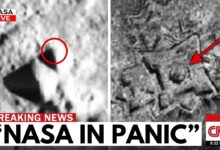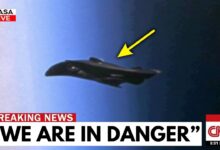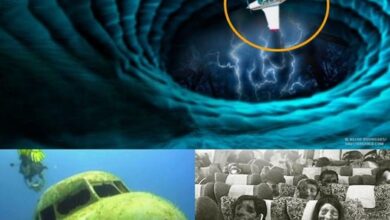NASA Tried To Hide What Was Found On The Dark Side Of The Moon
The Dark Side of the Moon: What Are They Hiding?
For decades, whispers have circulated about strange structures on the Moon — towers, domes, and shapes that seem anything but natural. One of the oldest lunar conspiracies claims that NASA has quietly edited these anomalies out of public photographs, especially those taken on the far side — the hidden hemisphere that never faces Earth.
Some of the most persistent claims come from a single photo: AS11-38-5564, taken during Apollo 11. Early viewers swore it showed a massive, unnatural structure near the edge of a crater. But when people returned later to download the high-resolution image, it was either blurred beyond recognition… or simply gone.
This wasn’t an isolated case. Several farside photographs from the Lunar Orbiter missions allegedly suffered the same fate — crisp details replaced with low-quality substitutes, or entire files removed.
And then there’s the rumor of a secret photo-review team, working behind the scenes to “airbrush” anything too strange before the public ever sees it. That’s how the term “airbrushed by NASA” was born.
The Witnesses Who Spoke Out
In the 1960s, a U.S. Air Force photographic technician named Carl Wolf claimed he was shown classified lunar images that revealed enormous towers, domes, and radar-dish-like structures on the far side.
Another former military man, Bob Dean, echoed his account:
“We’ve known about nonhuman structures on the Moon for years.”
Neither man ever produced physical proof, but their testimonies have become staples in UFO circles.
According to this theory, the Apollo program wasn’t purely about exploration — it was reconnaissance. The story goes that during these missions, contact was made, a warning was issued… and NASA never returned. Officially, budget cuts ended the program. But for believers, that explanation is far too convenient.
The Chinese Rover’s Mystery Discovery
In 2019, China’s Yutu-2 rover became the first to explore the far side of the Moon. Rolling into a small crater, it spotted something unexpected: a shiny, greenish “gel-like” substance.
The Moon is dry and dusty — so what could possibly look like wet gel? The rover team was so surprised, they halted their mission and returned for a closer inspection.
Later analysis suggested it was likely glassy rock, created when a meteor impact melted lunar soil. But the reflective, alien-like sheen was enough to ignite speculation online — theories ranging from alien fuel leaks to living organisms liquefying under sunlight.
Structures in Paracelsus C Crater
One hotspot for alleged anomalies is the far side’s Paracelsus C crater. In 2016, image analyst Mark Carlotto examined NASA’s Lunar Reconnaissance Orbiter images and pointed out geometric forms inside — corridors, tower-like shapes, and what he described as a massive platform.
He emphasized their alignment: sharp 90-degree angles, unlike natural formations. NASA’s stance? Pareidolia — the human tendency to see patterns where none exist. But multiple images from different angles appear to show the same formations.
The Compton–Belkovich Anomaly
There’s a location on the far side that stands out in scans for radioactive material — the Compton–Belkovich Thorium Anomaly. Thorium is rare on the Moon, yet here it exists in unusually high concentrations.
The terrain here is also odd: instead of typical craters and plains, the surface bulges upward, suggesting ancient volcanic activity in a region where such activity “shouldn’t” happen.
Lunar Swirls and Magnetic Oddities
Across the Moon’s surface are pale, swirling patterns called lunar swirls — like enormous white brushstrokes across the gray dust. One of the largest, Reiner Gamma, has no impact crater associated with it.
Strangely, these swirls correspond with localized magnetic anomalies. The Moon no longer has a global magnetic field, so where is this magnetism coming from?
Transient Lunar Phenomena (TLPs)
For centuries, astronomers have reported brief flashes, glows, or color changes on the Moon — known as transient lunar phenomena. They last seconds, sometimes minutes, and then vanish.
Explanations have ranged from gas venting to electrostatic dust being illuminated — but none fully account for the variety and frequency of these sightings.
Perfect Circles and Hidden Gravity
Many lunar craters are eerily perfect circles, regardless of the angle of impact. Stranger still, NASA discovered mascons — hidden pockets of mass beneath the surface that alter a spacecraft’s trajectory.
These anomalies don’t always align with visible surface features. Some conspiracy theorists speculate they could be caused by buried technology or massive underground structures.
When the Moon Rang Like a Bell
During Apollo 12, NASA intentionally crashed part of its lunar module into the Moon. Seismic sensors recorded the vibrations… for nearly an hour.
Scientists explained this as a result of the Moon’s dry, rigid interior — shockwaves travel farther and longer without water to dampen them. But to many, it fueled the theory that the Moon is hollow, or at least contains vast empty chambers.
Some even claim it’s not a natural body at all, but an ancient, artificial satellite.
Heat Where There Should Be None
Recent thermal scans have revealed hotspots deep beneath the lunar surface, some clustered on the far side. The Moon has been geologically dead for billions of years — so why are certain areas still warm?
Possible explanations include radioactive decay or residual lava pockets… but if the source isn’t natural, what could it be?
What Yutu-2 Found Underground
Using ground-penetrating radar, Yutu-2 mapped the far side’s subsurface and found something surprising: multiple distinct layers, extending about 40 meters deep.
Instead of solid bedrock, the rover detected stacked strata — dust, rock debris, and possible ancient lava flows. Some layers appeared oddly structured, almost as if shaped or built over time.
While no one is claiming “alien bases,” the complexity suggests the far side hides far more history — and mystery — than we’ve ever seen from Earth.
The Moon’s hidden hemisphere has only just begun to be explored. And whether the anomalies are optical illusions, geological quirks, or something far stranger… the far side still holds secrets that have yet to be revealed.




